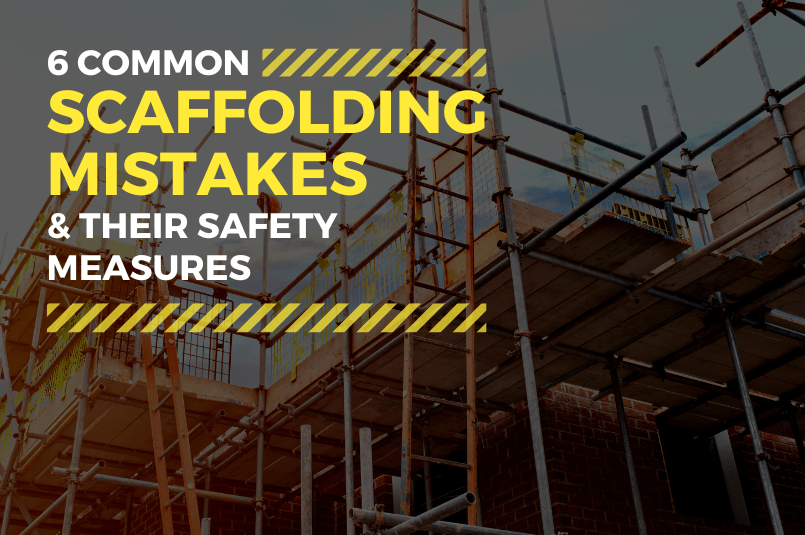
Scaffolding is the basic building block and a temporary structure that is used to support work crews and loads, to aid the construction process. As the demand for construction is rising every year, so is the need for scaffoldings. Further, as the need for scaffolding is rising, the risks associated with it are also rising. And as the risks are rising, so are the number of fatalities and accidental injuries at construction sites.
It is a cascading effect, and thus, it is necessary to prevent such accidents as much as possible. Thus, in light of prevention, here are the top 6 common scaffolding mistakes and their safety measures.
6 Common Scaffolding Mistakes & Their Safety Measures
- 1. Scaffold Overloading
According to scaffolding standards, a scaffold must support at least four times the maximum intended load. But in many cases,
- The work crew carry the maximum load in one go
- The extra tools or materials are stored on the scaffold
- Too many workers work on a single plank
These actions may lead to rupture of material or crack. It is exposed to the risk of complete breakage, which can collapse the entire framework, leading to accidents.
How to mitigate the risk?
Do not overload a scaffold. The maximum intended loads are specified by the manufacturers, which should not be exceeded. The load-bearing timber members must be at least 1,500 lb-f/in2 construction grade timber.
- 2. Not clearing up debris & materials
Materials & tools are the essentials in construction. Thus, the work crew need those while working at a height. But in many cases,
- Workers leave behind the materials after work
- They do not clean the debris at the construction site
- They may spill liquid at the site.
These actions may lead to severe injuries & can even cause someone to fall off the scaffolding. Moreover, if these materials fall off from a height on a person, it may lead to severe injury.
How to mitigate the risk?
Clear up the working space after work, everyday. Make sure that no tools or materials are left unattended on the scaffold. A routine cleaning practice is essential to prevent this hazard.
- Inaccuracy in scaffold building
The scaffolding should be constructed properly by using manuals. The bolts and fixators should be checked twice before starting work. But in many cases,
- Workers keep loose points in planks that make them unstable
- Haphazard scaffold construction
- Overloading the bases of structure
- Use inappropriate construction parts
- Use scaffoldings from different manufacturers
This may lead to unstable platforms & increase the probability of a collapse. It may cause severe damage to the entire framework and can pose harm to workers. Workers can also get electrocuted if the scaffold site is next to the powerline.
How to mitigate the risk?
Human errors are inevitable but can be minimized. This can be done by a proper conversation of scaffolding plans. Make sure to inspect fasteners, planks, beams, and that all the materials are fixed properly. Considering the local weather conditions and using safety measures accordingly is also important.
- Lack of fall prevention
Including personal protection equipment (PPE) & proper training on handling scaffolding, workers can create a safe environment. But in many cases,
- Workers do not gear themselves up while working at a height
- They do not clear up scaffolding planks
- They do not wear PPE
In all these cases, workers are prone to fatalities due to falling from a height.
How to mitigate the risk?
When working at a height, scaffolding safety has to be considered. The precautions include- fall arrest systems, PPE, guard rails & following safety standards above the height of 10 feet. The anchoring points used for fall arrest equipment must support a minimum of 5000 pounds per attached employee.
- Inappropriate suspended scaffolds
Platforms which are suspended by ropes or other non-rigid means like boatswain’s chair, elevator false car, interior hang, etc. are all risky supports for workers. While working on such platforms,
- Workers are not trained
- The supporting cables are not as strong as mentioned by standards
- Platforms are not prevented from swaying
- Workers do not wear guards or PPE
In all the above cases, the probability of falls due to instability of platforms is more.
How to mitigate the risk?
The contractor should ensure the loading standards of the suspended platforms. Workers should be trained properly & wearing PPE should be a compulsion. The platforms above 24 inches should be accessed with ladders, ramps, walkways or similar surfaces. The diameter of ropes used in such assembly should have a wide surface area for the functioning of brake & hoist mechanisms.
- Untrained employees
Lack of training amongst employees in their ways of climbing, moving & working on scaffolds leads to personal accidents. In this case,
- Untrained employees will not be aware of all the hazards at the working site
- They won’t recognize danger signs in the scaffold structure
- They may fail to use PPE & won’t clean the area after work
This may lead to unnecessary injuries and accidents.
How to mitigate the risk?
Training of every employee is a must. Further, contractors should overview the entire working space prior to work and after completion of work, each day. The rules regarding the usage of gears & PPE should be solidified.
Takeaway
Execution of any construction work is proportional to the risk associated with it. It is necessary to identify and mitigate those as soon as possible. The use of proper techniques & standard equipment enhances safety and reduces risk.
Scaffolding Supply- The leading scaffolding manufacturer in USA provides standard scaffolding equipment that ensures long life and greater safety. We keep safety as a priority while producing equipment & follow standards noted by OSHA. Hope the blog was insightful. To get access to more safety and standard equipment for scaffolding, visit scaffoldingsupply.com











Comments are closed